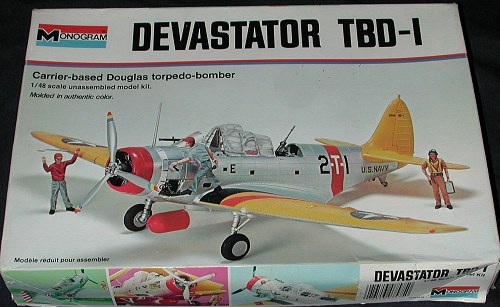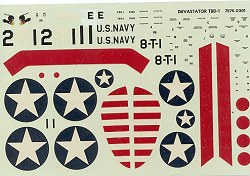
|
KIT: |
Monogram 1/48 TBD-1 Devestator |
|
KIT # |
7575 |
|
PRICE: |
@ $10-15 |
|
DECALS: |
Three options |
|
REVIEWER: |
Scott Van Aken |
|
NOTES: |

|
HISTORY |
Though the new Grumman TBF "Avenger" was entering production as its intended replacement, the TBD-1 was the Pacific Fleet's sole torpedo plane for the first part of the war against Japan. It seemingly did well in the raids of February-March 1942 and in the Battle of the Coral Sea in early May, serving in both the torpedo attack and high-level bombing roles. However, in about an hour's time on 4 June 1942, during the Battle of Midway, the TBD entered the annals of Naval history as a synonym for costly futility. Three squadrons of TBD-1s made heroic torpedo attacks on the Japanese carrier force, losing all but four of forty-one aircraft while achieving no hits. Old and slow, with a weak defensive armament and without self-sealing fuel tanks, the TBD had proven horribly vulnerable to enemy fighters, though this vulnerability was to a great extent typical of all torpedo attacks against well-defended ships.
At the end of the Midway battle, the Navy had just thirty-nine TBDs left. New "Avengers" quickly took their place on Pacific Fleet flight decks, but the older planes continued to serve (briefly) in the Atlantic Fleet and in training squadrons until late 1943. The twenty-one TBDs left in the Navy inventory at the start of 1944 were mainly employed as stationary hulks for maintainance training, and all were gone by the end of that year. There are no surviving TBDs today, though hope exists for recovery, restoration and exhibit of a plane lost at sea.
The TBD's short production life, and specialized intended employment, precluded much variety in the type. The first production unit was converted to a floatplane, designated TBD-1A, and used for tests well into World War II. With the 1941 adoption of "popular" names for Navy aircraft, the TBD began to be called the "Devastator", but for most of its operational life, it was just known as the TBD-1.
Thanks to the US Navy Museum for the historical background.|
THE KIT |

Probably as long running in terms of production at Monogram as their P-61, the TBD has been bought by the tens of thousands by modelers all over the world. This 1974 kit is still pretty much the best one on the market in any scale and thanks to Monogram's conscientious attention to detail, it will be a while before it is bettered.
Coming from the 'raised panel' era should not put off the prospective modeler as much of the plane is covered in corrugations! Devoid of the operating features that were so common in the 60s, this kit provides a most complete cockpit, the ability to have the wings folded and the ability to set it up for either bombs or a torpedo. There are separate bomb aimer's doors and those can be positioned open if one desires. There are also separate flaps that can be positioned down if one wishes. There are two accessory compartment access panels that can be posed open. One side shows the forward .30 machine gun while the other can have a crewman standing on it in preparation to operate the inertial starter to get the engine going. The final option is to have the canopy open and stacked in position.
 Instructions
are excellent and provide both the usual construction drawings and a step
by step written sequence with little check boxes so that you can ensure you
are following along properly. A color chart is provided showing
'Monogram-Humbrol' paints, but I'd bet the Humbrol numbers are obsolete.
Markings are for three planes. One is the box top aircraft in the pre-war
scheme from VT-2 aboard the USS Lexington. The other two are in the blue
grey over light grey scheme. One from VT-8 aboard the Hornet and with the
red/white tail stripes. The other a post Coral Sea plane from VT-6 aboard
the USS Enterprise. Decals are well printed and very glossy. Monogram had a
checkered history of having good decals back in the 70's, 80's and early
90's. However, with the advent of the outstanding Yellow Wings decal sets,
there is no need to use the kit decals for your pre-war marked Devastator.
Instructions
are excellent and provide both the usual construction drawings and a step
by step written sequence with little check boxes so that you can ensure you
are following along properly. A color chart is provided showing
'Monogram-Humbrol' paints, but I'd bet the Humbrol numbers are obsolete.
Markings are for three planes. One is the box top aircraft in the pre-war
scheme from VT-2 aboard the USS Lexington. The other two are in the blue
grey over light grey scheme. One from VT-8 aboard the Hornet and with the
red/white tail stripes. The other a post Coral Sea plane from VT-6 aboard
the USS Enterprise. Decals are well printed and very glossy. Monogram had a
checkered history of having good decals back in the 70's, 80's and early
90's. However, with the advent of the outstanding Yellow Wings decal sets,
there is no need to use the kit decals for your pre-war marked Devastator.
|
CONCLUSIONS |
This is a really fine kit that builds into a very impressive model. What's more, it is easy to find just about anywhere.
If you would like your product reviewed fairly and quickly by a site that has over 250,000 visitors a month, please contact me or see other details in the Note to Contributors.